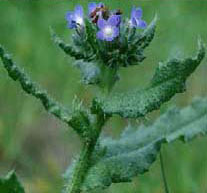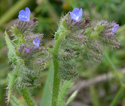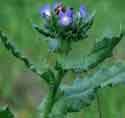Annual Bugloss
Anchusa arvensis • Class B |
||
| Family Name: | Boraginaceae (Bor-AJ-in-nee-see-ee) | |
| Common: | Forget-me-not family | |
| Genus: |
Anchusa (an-KOO-suh Meaning: Plant used for cosmetic; as a rouge perhaps |
|
| Species: |
arvensis (ar-VEN-sis) Meaning: Of farmed or cultivated land |
|
| Description: |
Annual Bugloss is a small leafy herb that grows about 1 to 3 feet tall. Slender lance-shaped leaves grow alternately up its branching stem and are covered in bristly hairs and crinkled on the edges. Leaves get smaller in size going up the stem. Flowers are funnel shaped and sky blue with 5 petals flaring from a white center. Each flower produces four nutlets, each containing one seed. |
||||
| Why Is it a Noxious Weed? |
It has become a problem in croplands, pastures, and fields, competing with native plants and crops. Because its seeds can remain dormant for many years, it has become a persistent weed problem. Annual Bugloss is in the borage family, of which many species contain alkaloids that are toxic to livestock and humans.
|
||||
| Where Does it Grow? |
Preferred habitat is roadsides, disturbed habitats, pasture and cultivated fields. It prefers sandy, alkaline soil. |
||||
| Control Options: |
|
||||
| More Information: |
For more information on this noxious weed Download our Flyer or visit Washington State Noxious Weed Control Board Here
|
||||
| More Pictures: |
|



